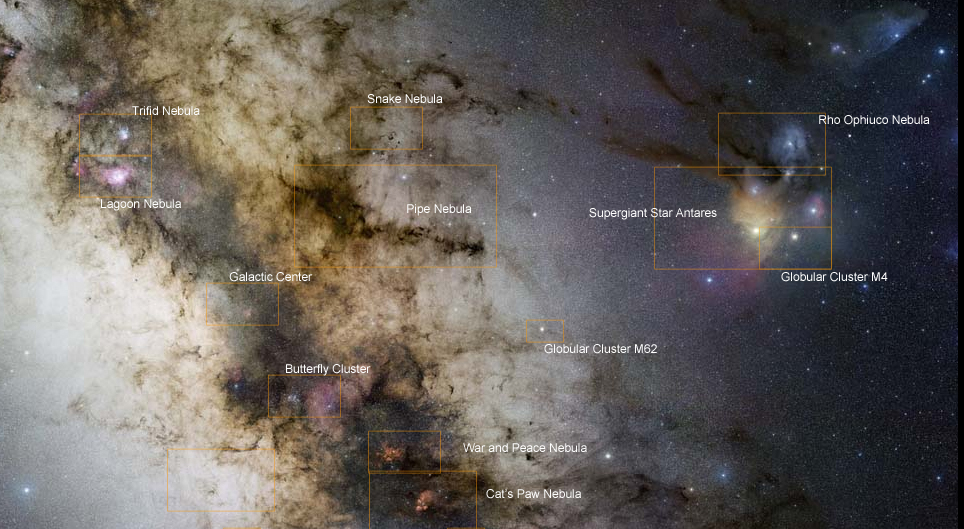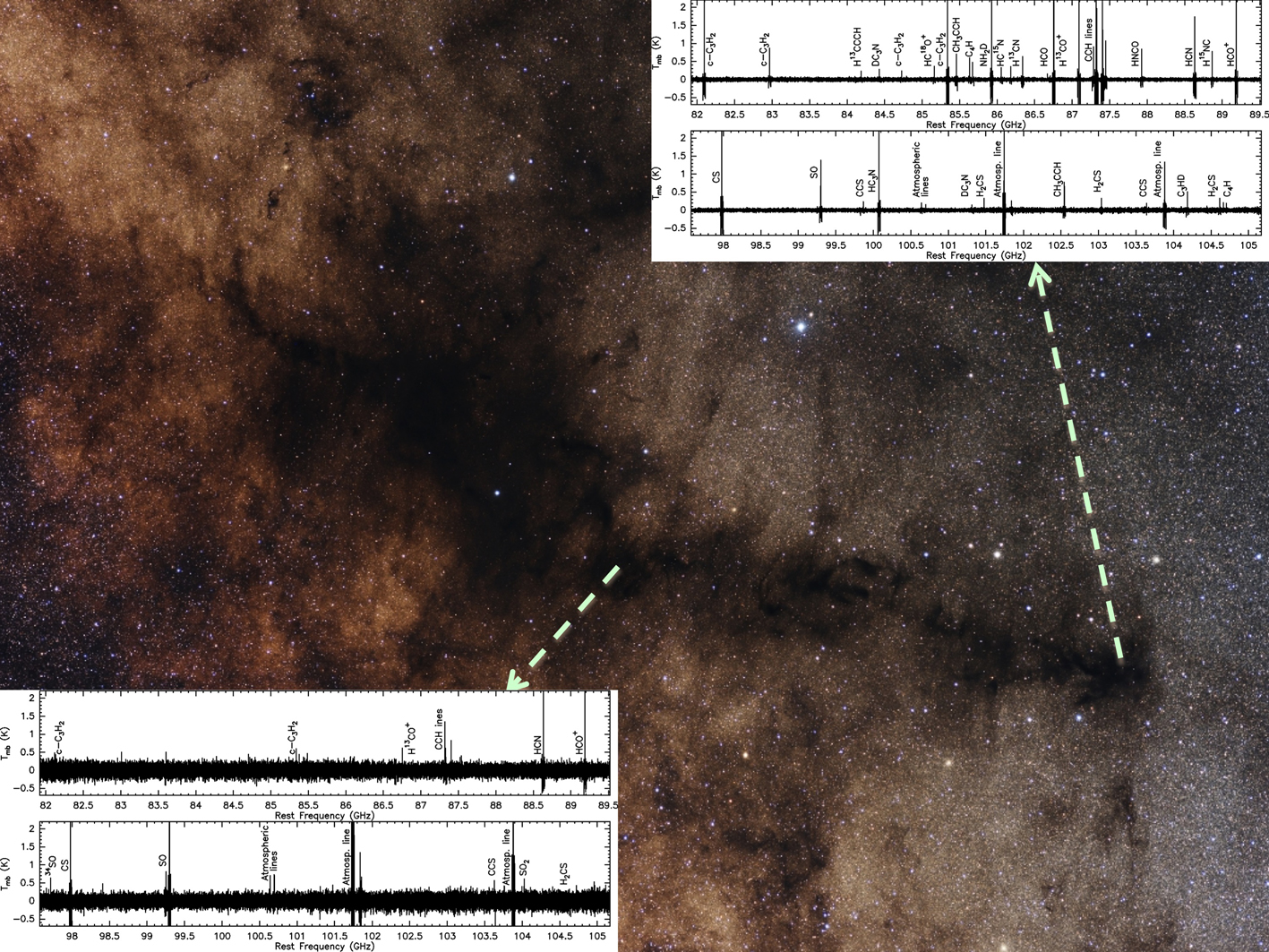News
Cold core chemistry unravelled
Star formation is a complex process that takes place in dense molecular cores, which are very cold (temperatures are close to −250◦C) and dense regions embedded in molecular clouds, or nebulae. They are composed of molecular hydrogen (H2) and, in a lower amount, of helium and signs of more complex molecules. Since H2 cannot be detected at radio wavelengths, astronomers observe different molecular species to trace its presence.
 A team of astronomers – Pau Frau and Josep Miquel Girart from the Institut de Ciencies de l’Espai (CSIC-IEEC), Catalonia, Spain and Maria Teresa Beltran from the INAF Osservatorio Astrofisico di Arcetri, Italy – used the IRAM 30m telescope to study the chemistry of the dense molecular cores embedded in the Pipe nebula. They were able to classify the evolutionary stage of the dense molecular cores, which are the previous step to forming stars, as a function of the molecules that compose them. Furthermore, on the basis of this analysis, the astronomers discovered a dense core in which the process of star formation failed.
A team of astronomers – Pau Frau and Josep Miquel Girart from the Institut de Ciencies de l’Espai (CSIC-IEEC), Catalonia, Spain and Maria Teresa Beltran from the INAF Osservatorio Astrofisico di Arcetri, Italy – used the IRAM 30m telescope to study the chemistry of the dense molecular cores embedded in the Pipe nebula. They were able to classify the evolutionary stage of the dense molecular cores, which are the previous step to forming stars, as a function of the molecules that compose them. Furthermore, on the basis of this analysis, the astronomers discovered a dense core in which the process of star formation failed.
The Pipe nebula is located in the Ophiuchus constellation at a distance of 470 light-years. It is visible to the unaided eye as a black spot with the shape of a pipe in front of a bright background of stars that comprise the galactic center. This nebula is known to harbor more than one hundred dense molecular cores with masses similar to that of the Sun. The Pipe nebula is peculiar because it hosts very few forming stars, while clouds with similar size and mass as those located in the constellations of Taurus or Perseus present hundreds of young stars.
The study of the Pipe nebula was performed using the IRAM 30m telescope, located at Pico Veleta in Granada at an altitude of 2850 m. Using the new FTS spectrometer, which delivers a high spectral resolution and a huge bandwidth capable of observing half of the spectral range visible from Earth in the 3 mm wavelength, the astronomers obtained spectra of fourteen dense cores spread out over the whole Pipe nebula region. Through an extensive and intensive study, the astronomers determined the different molecular species present in the dense cores and, from their different behavior related to the density, they classified or grouped the cores within different evolutionary stages. While the less dense cores present a poorer chemical composition, the denser cores are more chemically rich.
 The study has been able to characterize the missing link in the stages previous to star formation since the composition of the molecular clouds and more evolved cores hosting protostars were known quite well, but not the composition of the dense molecular cores that represent an intermediate stage. The analysis of these fourteen cores allowed the determination, ordering and classification of the molecules expected to be present in the different evolutionary stages, in phases prior to the irreversible onset of the formation or birth of a star. Thanks to this detailed study, the group of astronomers also discovered one core which has a complex chemistry that does not coincide with those of other cores of similar density. Such a core seems to be disintegrating and, therefore, will never form a star. A plausible explanation is that an external shattering force is dispersing it. For that reason, the astronomers call it a failed core.
The study has been able to characterize the missing link in the stages previous to star formation since the composition of the molecular clouds and more evolved cores hosting protostars were known quite well, but not the composition of the dense molecular cores that represent an intermediate stage. The analysis of these fourteen cores allowed the determination, ordering and classification of the molecules expected to be present in the different evolutionary stages, in phases prior to the irreversible onset of the formation or birth of a star. Thanks to this detailed study, the group of astronomers also discovered one core which has a complex chemistry that does not coincide with those of other cores of similar density. Such a core seems to be disintegrating and, therefore, will never form a star. A plausible explanation is that an external shattering force is dispersing it. For that reason, the astronomers call it a failed core.
Contact information:
Pau Frau
Institut de Ciencies de l’Espai (CSIC-IEEC)
Campus UAB, Facultat de Ciencies, Torre C5-p, 2n pis 08193, Bellaterra, Barcelona, Spain
Email: frau@ice.cat
Phone: +34 93 581 4376
Josep Miquel Girart
Institut de Ciencies de l’Espai (CSIC-IEEC)
Email: girart@ice.cat
Phone: +34 93 581 4372
Maria Teresa Beltran INAF-Osservatorio Astrofisico di Arcetri Largo Enrico Fermi, 5
50125, Firenze, Italy
Email: mbeltran@arcetri.astro.it
Phone: +39 055 2752 215
More information:
The article was referenced in ScienceShot and published in Astronomy & Astrophysics.



